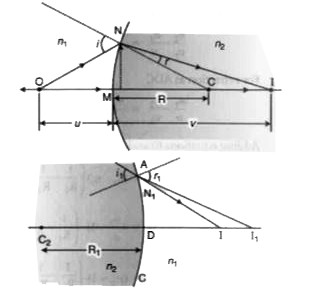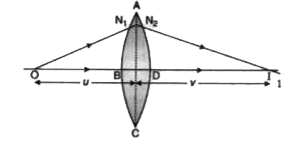Draw a ray diagram showing the formation of the image by a point object on the principal axis of a spherical convex surface separating two media of refractive indices n1 and n2, when a point source is kept in rarer medium of refractive index n1. Derive the relation between object and image distance in terms of refractive index of the medium and radium of curvature of the surface.
Hence obtain the expression for lens-maker's formula in the case of thin convex lens. Solution in Kannada

The incident rays coming from the object .O. kept in the rarer medium of refractive index n1, incident on the refracting surface NM produce the real image at I.
From the diagram,
∠i=∠NOM+∠NCM
=NMOM+NMMC
∠r=∠NCM−∠NIM
=NMMC−NMMI
From Snell.s law,
∴n2n1=sinisinr~ir ( for small angles, sinθ~θ)
∴n2r=n1i
or n2(NMMC−NMMI)=n1(NMOM+NMMC)
or n2(1+R−1+v)=n1(1−u+1R)
or n2−n1R=n2v−n1u
Lens maker.s formula :

The first refracting surface ABC forms the image I1 of the object O. The image I1 acts as a virtual object for the second refracting surface ADC which forms the real image I as shown in the diagram.
:. For refraction at ABC
n2v1−n1u=n2−n1R1 ....(i)
For refraction at ADC
n1v−n2v1=n1−n2R2 ....(ii)
Adding equations (i) and (ii) , we get
n1v−n1u=(n2−n1)(1R1−1R2)
1v−1u=(n2n1−1)(1R1−1R2)
1f=(μ21−1)(1R1−1R2)
Topper's Solved these Questions
- RAY OPTICS AND OPTICAL INSTRUMENTSBOOK - OSWAAL PUBLICATIONCHAPTER - RAY OPTICS AND OPTICAL INSTRUMENTSEXERCISE - TOPIC-1(NUMERICAL PROBLEMS)
9 Videos
- RAY OPTICS AND OPTICAL INSTRUMENTSBOOK - OSWAAL PUBLICATIONCHAPTER - RAY OPTICS AND OPTICAL INSTRUMENTSEXERCISE - TOPIC-2(VERY SHORT ANSWER TYPE QUESTIONS)
4 Videos
- RAY OPTICS AND OPTICAL INSTRUMENTSBOOK - OSWAAL PUBLICATIONCHAPTER - RAY OPTICS AND OPTICAL INSTRUMENTSEXERCISE - TOPIC-1(SHORT ANSWER TYPE QUESTIONS-2)
6 Videos
- NUCLEIBOOK - OSWAAL PUBLICATIONCHAPTER - NUCLEIEXERCISE - TOPIC -2 (Numerical Problems)
3 Videos
- Sample Paper 1BOOK - OSWAAL PUBLICATIONCHAPTER - Sample Paper 1EXERCISE - Exercise
36 Videos
Similar Questions
A convex lens of focal length 0.24 m and of refractive index 1.5 is completely immersed in water of refractive 1.33. Find the changes in the focal length of the lens.
View SolutionWhat is dispersion of light?
View SolutionDerive the relation f=R/2 in the case of a concave mirror.
View SolutionThe half life of 38Sr90 isotope is 28 years. What is the rate of disintegration of 15 mg of this isotope? (Given Avogadro No =6.023×1023)
View SolutionCharges of 10μC and 15μC are separated by a certain distance. Which charge repels the other with a greater force?
View Solution(a) Draw the ray diagram showing the geometry of formation of the image of a point object situated on the principal axis, and on the convex side, of a spherical of radius of curvature R . Taking the rays as incident from a medium of refractive index n_(1) to anothr of refractive index n_(2) show that (n_(2))/(v)-(n_(1))/(u)=(n_(2)-n_(1))/(R) where the symbols have their usual meaning. (b) Use this relation to obtain the (thin) lens maker's formula.
View Solution(i) Device the mathematical n between refractive indices n1 and n2 of two radii and radius of curvature R for refraction at a convex shperical surface. Consider the object to be a point since lying on the principal axis in rarer medium of refractive index n1 and a real image formed in the denser medium of refractive index n2. Hence, derive lens marker's formula.
(ii) Light from a point source in air falls on a convex spherical glass surface of refractive index 1.5 and radius of curvature 20cm. The distance of light source from the glass surface is 100cm. At what position is the image formed ?
View Solutionn1 तथा n2 अपवर्तनांक के दो माध्यमों को अलग करने वाले उत्तल गोलीय पृष्ट के लिये अपवर्तन सम्बन्धी सूत्र स्थापित कीजिए |
View SolutionA point object 'O' on the principal axis of a spherical surface of radius of curvature 'R' separating two media of refractive indices n_(1) and n_(2) forms an image 'I' as shown in the figure below. Prove that (n_(2))/(v)-(n_(1))/(v)=(n_(2)-n_(1))/(R)
View Solutionn1 और n2 अपवर्तनांकों वाले दो माध्यमों को पृथक करने वाले गोलीय पृष्ठ के अक्ष पर पड़ी एक बिन्दु वस्तु के प्रतिबिम्ब की रचना दिखने वाली प्रकाश किरणों का अनुरेखण करें | वस्तु और प्रतिबिम्ब की दूरियों और गोलीय पृष्ठ के केन्द्रीय बिन्दु से वक्रता व्यासार्ध के बीच सम्बन्ध स्थापित करें | इससे लेन्स निर्माता सूत्र के लिए व्यंजक निकालें |
View Solution(a) Obtain Lens Maker's formula using the expression
n2v−n1u=(n2−n1)R
Here the ray of light propagating from a rarer medium of refractive index (n1) to a denser medium of refractive index (n2) is incident on the convex side of spherical refracting surface of radius of curvature R.
(b) Draw a ray diagram to show the image formation by a concave mirror when the object is kept between its focus and the pole. Using this diagram , derive the magnification formula for the image formed.
View SolutionObtain lens maker's formula using the expression n2v−n1u=n2−n1R, propagating from a rarer medium of refractive index (n1) to a denser medium of refractive index (n2) is incident on the convex side of spherical refracting surface of radius of curvature R.
View SolutionDraw a ray diagram to show the formation of the real image of a point object due to a convex spherical refracting surface, when the ray of light is travelling from a rarer medium of refractive index nx to a denser medium of refractive index n_(2) . Using this diagram derive the relation between object distance (w), image distance (v), radius of curvature (R) of a convex spherical surface. State the sign convention and the assumptions used.
View Solution(a) A point object is placed on the principal axis of a convex spherical surface of radius of curvature R, which separates the two media of refractive indices nx and n2(n2>n1)
Draw the ray diagram and deduce the relation between the object distance (w), image distance (v) and the radius of curvature (R) for refraction to take place at the convex spherical surface from rarer to denser medium.
(b) A converging lens has a focal length of 20 cm in air. It is made of a material of refractive index 1.6. If it is immersed in a liquid of refractive index 1.3, find its new focal length.
View SolutionDerive the mathematical relation between refractive indices n_(1) and n_2 of two media and radius of curvature R for refraction at a convex spherical surface. Consider the object to be a point one lying on the principal axis in rarer medium of refractive index nt and a real image formed in the denser medium of refractive index n_2 . Hence, derive lens maker's formula. (ii) Light from a point source in air falls on a convex spherical glass surface of refractive index 1.5 and radius of curvature 20 cm. The distance of light source from the glass surface is 100 cm. At what position is the image formed ?
View Solution
